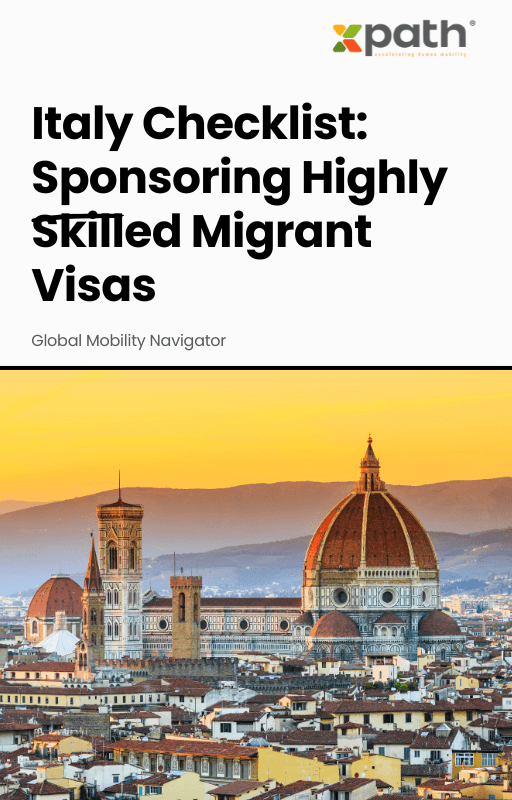Italy Checklist: Sponsoring Highly Skilled Migrant Visas
Grab a copy of a guide to international employee relocation
View E-bookImagine this: You’ve just landed a big international assignment, but before you can start dreaming about new adventures, you’re knee-deep in paperwork, compliance headaches, and a tangle of outdated systems that feel more “90s nostalgia” than future-ready. If that resonates, you’re not alone. The global workforce is more mobile than ever, but the behind-the-scenes magic—moving talent seamlessly across borders—often stumbles when legacy tech meets modern expectations. “Global mobility solution” isn’t just another corporate buzzword; it’s the secret sauce that can spell the difference between employee satisfaction and attrition. But how big is the gap between traditional and modern platforms? Let’s crunch the numbers and see what’s really at stake.
Legacy systems are like the sturdy old sedans of the HR world—reliable in their day but struggling to keep up with today’s fast lanes. These platforms, often built decades ago, rely heavily on manual processes, siloed data, and rigid structures. They were designed for a time when global assignments were rare, compliance was simpler, and employee expectations were less demanding.
But with LinkedIn reporting that cross-border assignments have grown by 25% since 2019, and Deloitte estimating that over 72% of multinational organizations expect to increase employee mobility post-pandemic, these old tools are showing serious wear and tear. They simply weren’t built for the complexity and velocity of modern talent movement.
Enter the new wave of global mobility solution providers. Think of them as the Teslas of the relocation world—sleek, data-driven, and designed for how we work today. Modern platforms harness the power of the cloud, integrate seamlessly with HRIS, payroll, and travel systems, and provide real-time data for everyone from employees to managers and vendors.
The impact? According to a 2023 PwC survey, companies that have adopted integrated mobility tech are 40% more likely to report improved employee experience and 35% more efficient program administration. It’s not just about automating tasks; it’s about creating a connected ecosystem where compliance, cost control, and user satisfaction all move in harmony.
Let’s get into the weeds. Data from KPMG’s 2022 Global Assignment Policies and Practices Survey revealed that 67% of organizations still depend on spreadsheets or outdated local software to manage mobile talent. This often leads to:
Contrast this with modern solutions like xpath.global, which offer end-to-end digital workflows, built-in compliance modules, and dashboards that provide instant visibility into assignment status, costs, and employee satisfaction.
Don’t just take the tech providers’ word for it. Consider the journey of a Fortune 500 manufacturing firm encumbered by legacy tools. They reported a 30-day average lead time for international assignments—mostly due to back-and-forth emails and fragmented data. After switching to an integrated mobility solution, assignment initiation times dropped to under a week. Employee satisfaction soared, while the mobility team trimmed their admin time by nearly half.
Similarly, a global tech company using xpath.global managed to unify supplier management and compliance tracking across 40+ countries, reducing compliance risks by 60% and achieving a 25% reduction in relocation costs in their first year.
Of course, the switch isn’t entirely plug-and-play. Migrating from legacy to modern solutions means facing data migration, change management, and stakeholder buy-in. Yet, the payoff in agility, risk mitigation, and cost control is proving irresistible. According to Mercer’s 2023 trends report, over 50% of organizations are planning to upgrade to next-gen mobility platforms within the next 24 months.
Savvy providers like xpath.global help cushion this leap, offering scalable migration support, tailored training, and customizable integrations—so you don’t have to rip out your whole tech stack to see big gains.
Not all mobility platforms are created equal. As you evaluate solutions, look for cloud-native infrastructure, real-time analytics, compliance automation, and user-centric design. Integration capabilities matter too: Can your chosen platform connect to your existing HRIS, payroll, or travel management tools?
Xpath.global, for example, delivers a digital-first platform that streamlines everything from assignment planning to tax management—giving you a 360-degree view of your global mobility landscape. That’s what sets a true modern solution apart—it’s not just about going paperless, it’s about empowering people and removing friction from every step of the journey.
The data doesn’t lie. Legacy systems are roadblocks in a world where speed, transparency, and compliance spell the difference between thriving teams and stressed-out talent. Modern mobility solutions, led by platforms like xpath.global, have proven their value in efficiency, cost savings, and—most importantly—delighting the diverse global workforce of today.
Ready to accelerate your mobility strategy? Don’t let legacy slow you down—embrace the future with a modern, data-driven solution and watch both your program and your people flourish.
What is a global mobility solution?
A global mobility solution is a digital platform or suite of tools designed to manage and streamline the relocation, assignment, and compliance processes for international employees.
Why move away from legacy systems?
Legacy systems often lead to inefficiencies, data silos, and compliance risks. Modern solutions offer automation, real-time data, and better experiences for both employees and HR teams.
What should I look for in a modern mobility platform?
Top priorities include cloud-based access, integration with HR systems, automated compliance, customizable workflows, and user-friendly dashboards.
How hard is it to migrate from legacy systems?
While change requires planning and support, providers like xpath.global offer phased migration and expert onboarding to make the transition smooth.
What’s the ROI of upgrading?
Studies show up to 35% improved efficiency, reduced compliance risks, and higher relocation satisfaction—delivering measurable returns within the first year.
Ready to transform your mobility program? Explore xpath.global’s solutions.

Italy Checklist: Sponsoring Highly Skilled Migrant Visas
Grab a copy of a guide to international employee relocation
View E-book